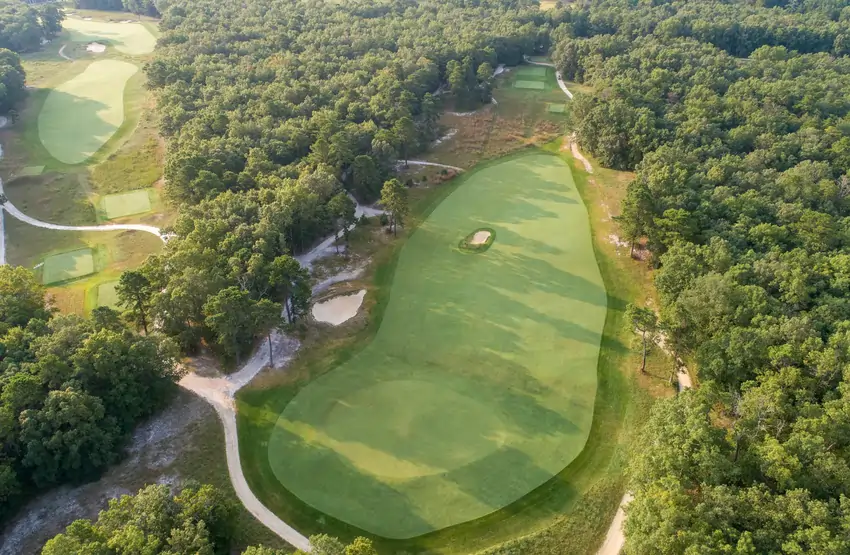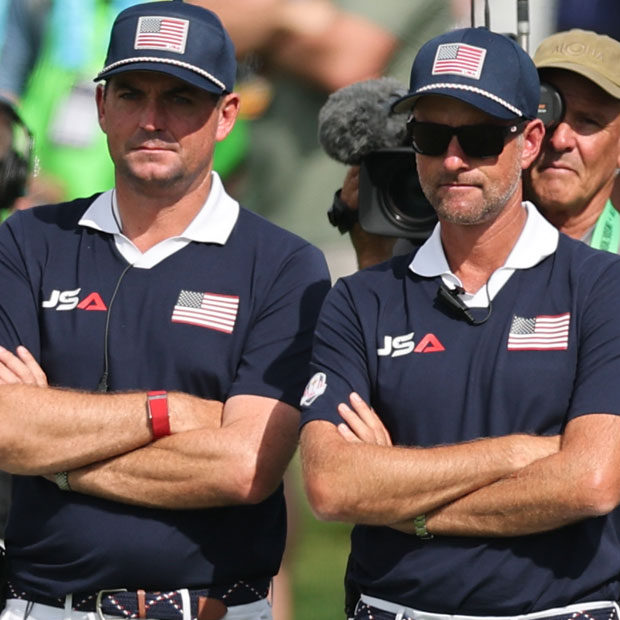We-Ko-Pa Golf Club (Saguaro Course)
A strategic, walkable course situated on diverse terrain, We-Ko-Pa is one of the best public golf options in the greater Phoenix area, if not THE best

Fort McDowell, Arizona, USA
Coore & Crenshaw (original design, 2006)
Semi-Private
$$$
The Saguaro Course, the second 18 at We-Ko-Pa Golf Club near Scottsdale, Arizona, was a departure from both its predecessor, the Cholla Course designed by Scott Miller, and Coore & Crenshaw’s own 36-hole layout at Talking Stick Resort in Scottsdale. Coore & Crenshaw had a unique topographical canvas at We-Ko-Pa, far more dramatic than the land they worked with at Talking Stick. However, they aimed to preserve walkability, an attribute noticeably absent from the Cholla Course. They crafted a strategic, walkable course over diverse terrain, making We-Ko-Pa one of the best public golf options in the greater Phoenix area, if not the best.
{{content-block-course-profile-we-ko-pa-golf-club-saguaro-course-001}}
Take Note…
Scottsdale Trails. The Saguaro Course, a rare walkable course in the desert, boasts meticulously maintained trails, making for a pleasant stroll.
The importance of a “desert club.” For those unaccustomed to desert golf or concerned about how their clubs look, bringing a less valuable club to We-Ko-Pa is wise. The desert can be brutal to golf equipment, and it’s inevitable that a shot or two will land in the waste. Save your primary clubs by having a spare to hack it out with.
Wrecking crew. Built in the early 2000s, We-Ko-Pa was fortunate to have a veritable dream team manning the bulldozers. The crew included esteemed Coore & Crenshaw shapers and associates like Rod Whitman, Dave Axland, Jeff Bradley, Jim Craig, Dave Zinkand, and Jimbo Wright.
Favorite Hole
No. 13, par 4, 466 yards
Coore & Crenshaw excel at crafting strategic holes on meh land, a talent exemplified the Saguaro Course’s 13th hole. Situated on one of the property’s duller piece of land, this long par 4 presents a beautiful question off the tee that dictates how the rest of the hole will play out.
Favorite Hole
No. 13, par 4, 466 yards
Coore & Crenshaw excel at crafting strategic holes on meh land, a talent exemplified the Saguaro Course’s 13th hole. Situated on one of the property’s duller piece of land, this long par 4 presents a beautiful question off the tee that dictates how the rest of the hole will play out.
The fairway, almost 70 yards wide, features bunkers in the center and on the left edge. The diagonal angle of the tee shot makes playing to the right, away from the punitive desert, feel more secure. However, choosing the right side results in a longer approach to a green that slopes away from you. Playing left, on the other hand, sets up a shorter approach aided by helping contours. It’s a prime example of well-balanced risk and reward in golf architecture, and masterful flat hole on an otherwise striking desert property.

{{content-block-course-profile-we-ko-pa-golf-club-saguaro-course-002}}
Overall Thoughts
You could argue that Coore & Crenshaw’s most inspired design period was the early to mid-2000s. Armed with a team of skilled associates, many of whom have since become accomplished architects themselves, C&C reeled off a run of courses that included Friar’s Head, Old Sandwich, and Bandon Trails. During this period, they also designed the Saguaro Course at We-Ko-Pa, a public-access golf course in Phoenix, one of the country’s densest golfing areas.
Architect Bill Coore, a Scottsdale resident, devoted substantial time to the routing process, honing the best cadence for the holes, and it shows. The routing of We-Ko-Pa creates diverse topographical interest while maintaining walkability. The site’s undulations are skillfully used, generating a variety of challenges throughout. Standout stretches include Nos. 4-8 and 14-16, which incorporate large-scale land movement in innovative ways that never feel redundant. Holes on more subtle terrain have bolder design characteristics, such as the adventurous contouring of the ninth and 10th greens, the big fronting bunker on No. 12, and the strategic complexity of the 13th hole, which I discussed above.
The stretch of Nos. 4-8 includes two par 5s, a par 3, and two par 4s. The par 5s, the fourth and eighth, bookend this sequence, differentiating themselves from each other by playing in different directions, one downhill (4) and the other uphill (8). These holes take full advantage of their topographical assets. The fourth is longer and offers a stunning downhill view after the semi-blind tee shot, while the eighth features massive bunkers set into the upslopes off the tee. While No. 8 is gettable, the small green has a clever little bump that makes long lag putts and up-and-down tries difficult.
The fifth, a small par 3 on modest ground, serves to transport golfers to the more interesting terrain of the sixth and seventh holes. Although a connector, the fifth is memorable because of its fantastic green, which reminds me of the fifth at Meadow Club, a MacKenzie interpretation of the Eden hole at St. Andrews.
The sixth and seventh holes play along the edge of a large ridge, which makes going left no bueno. No. 6, a tremendous par 4, rewards a tee shot up the dangerous left side with a better angle into the small, bunkerless green. Conversely, on the short par-4 seventh, the best spot to approach the diamond-shaped green is on the right, near a cluster of fairway bunkers. Any drives to the left will need to navigate the bunkers in front of the shallow green. It’s a delightful short par 4.
{{content-block-course-profile-we-ko-pa-golf-club-saguaro-course-003}}
The back nine boasts exciting topography from the 14th hole onward, with the stretch from 14 to 16 being my favorite. No. 14 is a split-fairway par 5 that plays uphill to a green perched in the foothills of a mountain range. Aiming right off the tee is risky but shortens the hole and provides the only route home in two. The 14th isn’t the only par 5 in the Coore & Crenshaw portfolio that makes the most of a split-fairway concept; they used it similarly at Sand Valley and Colorado Golf Club.
Next is the 15th, a long downhill par 3—likely the most photographed hole on the course. The green runs away and to the left, hugging the grade of the land. Here, unfortunately, you see the impact of overseeded ryegrass: the contouring of the approach to the green indicates that your ball should land short and to the right, but the grass renders this play inadvisable. Think of the effect of kikuyu on the fourth hole at Riviera.
The 16th, a short par 4 on the scorecard, plays significantly uphill, and again, positioning off the tee is critical. Going left is safe, but your next shot will be over a deep front bunker; going right avoids that bunker but brings fairway bunkers into play. Adding to the strategic challenge is how uphill the hole plays—so uphill that it reminded me of the approach on the 18th at Augusta National.
{{content-block-course-profile-we-ko-pa-golf-club-saguaro-course-004}}
The Saguaro Course’s highlights are fueled by topography, especially in the two stretches I’ve described. However, the entire course exhibits the timeless strategic principles I’ve seen in every Coore & Crenshaw design I have played. Those strategic virtues, coupled with what might be C&C’s peak era of naturalistic construction, make the Saguaro at We-Ko-Pa a must-play on any Scottsdale golf trip.
1 Egg
We-Ko-Pa Saguaro’s design is remarkable—that’s an Egg. While parts of the land are quite good, the property is nothing extraordinary.
All right, an extended note on presentation. We-Ko-Pa follows the common practice in desert regions of using overseeded ryegrass for fairways. This practice is prevalent because it creates lush green grass, offering a contrast to the harsh winter environments that many visitors want to escape. However, while visually appealing, ryegrass plays slow, which dampens the impact of Coore & Crenshaw’s design at We-Ko-Pa. I would be interested in seeing the Saguaro Course in the summer or fall, when the overseed is absent, but the use of pretty but less functional turf, along with the evolution of the tee boxes away from their original free-flowing nature, prevents the course from achieving an Egg in presentation.
Scottsdale National is a local example of a course that eschews overseeding, maintaining Bermudagrass year-round. For aesthetic purposes, they paint it green, which is cheaper and less water-intensive than overseeding. Personally, I prefer this method, which at least allows for firm conditions, but hopefully one day Arizona courses will simply embrace brown.
Course Tour

{{content-block-course-profile-we-ko-pa-golf-club-saguaro-course-005}}
Leave a comment or start a discussion
Get full access to exclusive benefits from Fried Egg Golf
- Member-only content
- Community discussions forums
- Member-only experiences and early access to events















Leave a comment or start a discussion
Lorem ipsum dolor sit amet, consectetur adipiscing elit. Suspendisse varius enim in eros elementum tristique. Duis cursus, mi quis viverra ornare, eros dolor interdum nulla, ut commodo diam libero vitae erat. Aenean faucibus nibh et justo cursus id rutrum lorem imperdiet. Nunc ut sem vitae risus tristique posuere. uis cursus, mi quis viverra ornare, eros dolor interdum nulla, ut commodo diam libero vitae erat. Aenean faucibus nibh et justo cursus id rutrum lorem imperdiet. Nunc ut sem vitae risus tristique posuere.